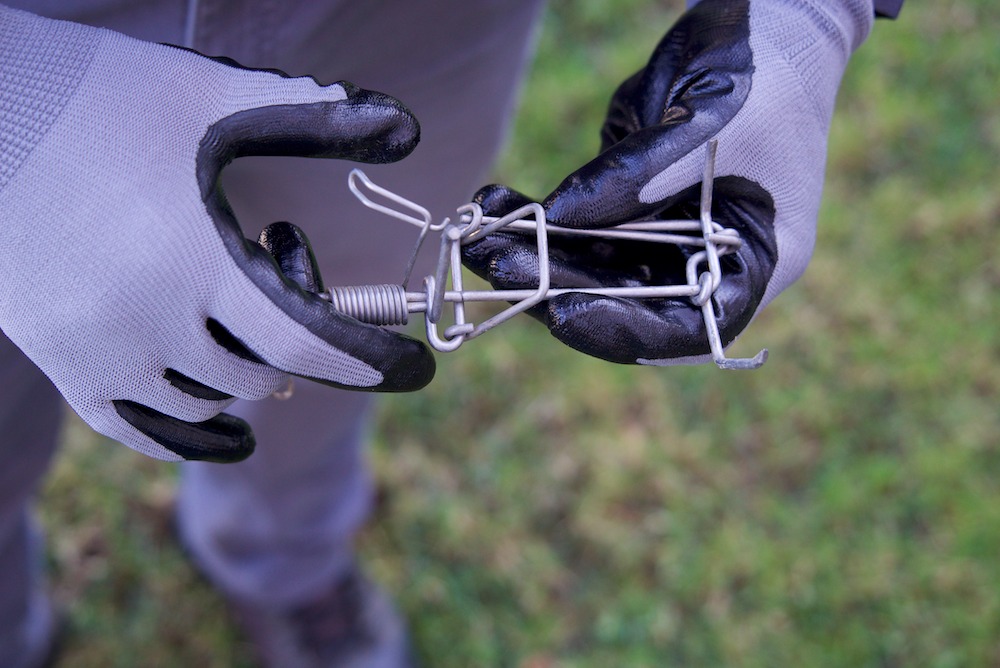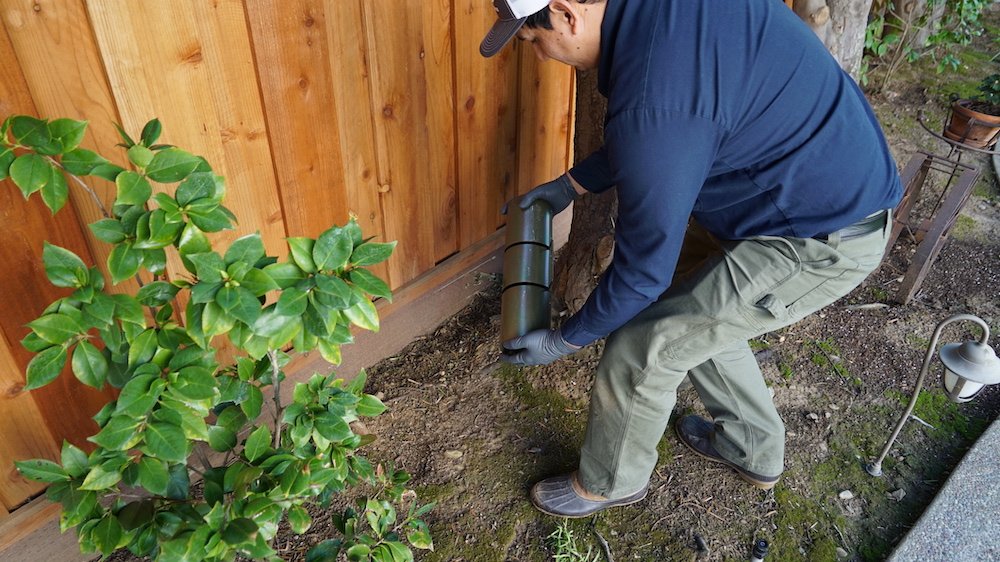Have you started noticing dirt piles and raised ridges in your lawn? If so, you probably have a mole problem.
Unless you act fast, moles can destroy your lawn and cause lots of unsightly damage.
Here at Smith’s Pest Management, we’ve been providing California residents with mole control services for 15+ years.
We’ve compiled our extensive experience into this guide to help you learn how to trap moles effectively.
Key Takeaways
- In order to successfully trap moles, first locate active mole tunnels, set the trap, and check it regularly.
- Trapping moles takes patience and consistency – we recommend setting several traps and letting them sit for as long as it takes.
- If you want faster results or you have a severe infestation, contact the professionals at Smith’s Pest Management: (408) 871-6988.
Before You Get Started
1. Identify Moles
Moles are small mammals with velvety fur, tiny eyes, and paddle-like forelimbs.
They create tunnels that can show up as huge piles and raised ridges in your lawn or garden (check out this video for an example).
Dying plants and uneven ground often signal their presence. If you’re struggling to differentiate between voles and moles, check out our blog.
2. Gather Your Equipment
Before starting, get the essentials: sturdy gloves, a shovel, a mole trap (like a scissor-jaw or tunnel trap), and a marker to track active tunnels.
Safety gear like knee pads and protective eyewear is also recommended.
3. Check Local Regulations
Before you go to work trapping moles, be sure to check your local wildlife laws.
Regulations on trapping and releasing wildlife can vary by region.
In some areas, it might be illegal or require special permits.
To avoid fines or legal issues, ensure you’re following local laws.
4. Select the Right Trap
Selecting the right trap is key for controlling moles in your lawn or garden.
How to do it:
- Assess Your Needs: Decide if you want to kill or capture the moles.
- Ease of Use: If you’re new to this, pick an easy-to-set-up trap.
- Safety: Choose traps that are safe if you have pets or children.
- Check Local Laws: Make sure the trap is legal in your area.
- Read Reviews: Look at feedback from other homeowners.
Here’s a simple overview of some common mole traps:
| Trap: | What It Is: | Pros: | Cons: |
| Scissor-Jaw Traps |
|
|
|
| Harpoon Traps |
|
|
|
| Live Traps |
|
|
|
| Choker Loop Traps |
|
|
|
How To Trap Moles Like a Pro

1. Locate Active Mole Tunnels
Moles create a network of tunnels in your lawn or garden.
These tunnels can be two main types: surface tunnels and deep tunnels.
Surface tunnels look like raised ridges and are used mainly for feeding.
Deep tunnels, however, are underground and act as the moles’ main highways and living areas. These tunnels can be anywhere from 4”-8” deep.
To place traps effectively, you need to find the active main tunnels since these are the paths moles use regularly.
How to do it:
- Look for Fresh Soil: Freshly dug soil usually means a new tunnel. Main tunnels will have more soil pushed out than feeding runways.
- Flatten and Monitor: Flatten part of the tunnel and check it after 24-48 hours. If it’s raised again, it means that the mole has repaired the damage and this is an active tunnel.
- Check After Rain: Moles are more active near the surface after rain. Look for fresh activity during these times.
- Probe the Tunnel: Use a thin rod or stick to gently probe the ground around suspected tunnels. Active main tunnels will offer less resistance since moles often return to these pathways.
2. Set the Trap
Setting a mole trap correctly can make a big difference in controlling mole populations.
To make your traps work, you need to set them in the right places and the right way.
How to do it:
- Set the Trap: If you’re using an “out-of-sight” trap designed to be placed directly in the tunnel, clean the tunnel out and place the trap so the mole will walk into it (if you need more specific instructions, check out this video). If you’re using a scissor- or harpoon-type trap or another model that works by shooting downward into the tunnel, you don’t need to open or clean the tunnel – just set it over the tunnel after you’ve broken the tunnel down. The moles will come back to try to repair the tunnel, and that activity will trigger the trap. For best results, set 3-5 traps in each target area.
- Leave the Trap: One important thing to know about moles is that they’re nomadic. They don’t stay in the places where you’re seeing their activity. They may spend some time in that area and then migrate over a neighbor’s property before coming back. Because of this, it’s important to be patient. It can take weeks to trap moles, so it’s essential to wait moles out and give your trapping program some time to work.
Important note: If you’re using live traps, follow all manufacturer instructions and monitor the trap closely to relocate the moles promptly and humanely.
3. Check the Trap Regularly
Regularly checking mole traps is critical for successful trapping.
Here’s why:
- Removing dead moles keeps the traps effective and ready for more moles.
- For live traps, frequent checks allow you to relocate the moles promptly and minimize their stress.
- Regular monitoring helps you decide if your traps are working, or if you need to adjust them or set more.
If you’re using a hidden trap, remove it every few weeks and check the area out – if the mole tunneled around it, simply re-set the trap in the new tunnel.
While moles are good at moving traps out of the way, you’ll generally succeed in trapping them if you keep adjusting your approach.
How to do it:
- Check Traps Daily: Examine traps at least once every 24 hours to ensure they are working properly and humanely.
- Remove Dead Moles: If you find a dead mole, remove it quickly and reset the trap to keep it effective.
- Release Live Moles: For live traps, relocate the captured mole to a suitable habitat far from your garden. Follow local wildlife regulations for relocation.
- Maintain Your Traps: Keep traps clean and in good working order. Make adjustments if traps are not catching moles effectively.
- Handle Traps Carefully to Avoid Injury: When using mole traps, always handle them with care. Wear sturdy gloves to protect your hands from sharp edges or pinch points. Be cautious of the trap’s mechanism, and keep your fingers clear when activating or deactivating it.
When to Call the Pros

Moles can be elusive pests, and controlling them can be a serious challenge.
Because of this, you may find that you need the help of a pro.
Professionals have the expertise, experience, and specialized tools to deal with moles effectively, and to keep you from pulling your hair out over DIY methods.
It may be time to consider calling a professional if:
- You’ve tried multiple traps without success.
- You are unsure about how to set traps humanely and effectively.
- You have a large infestation that’s causing serious damage to your space.
The pros guarantee more efficient and humane mole control and provide tips and preventive measures to keep the problem from recurring.
Mole Trapping Mistakes to Avoid
- Putting the Trap in the Wrong Place: Place traps directly in active mole tunnels. Incorrect placement leads to low catch rates and prolonged infestations.
- Using the Wrong Type of Trap: Different environments require different traps. Do your research and make sure you’re choosing the right trap for your space.
- Overlooking Signs of New Activity: Moles create new tunnels rapidly. Continuously monitor your garden for fresh activity and adjust your strategy accordingly – especially if moles are tunneling under or around your traps.
- Poor Trap Maintenance: Dirty or malfunctioning traps are less effective. Regularly clean and maintain your traps to ensure they work properly.
- Inconsistent Effort: Inconsistent trapping efforts lead to ongoing infestations. Stay persistent and patient and you’ll get rid of the moles eventually.
How to Prevent Mole Infestations
- Install Barriers: Create physical barriers by burying hardware cloth or metal mesh around your garden. Make sure it goes at least a foot underground to stop moles from tunneling in.
- Eliminate Food Sources: Moles eat insects, grubs, and worms. Managing these populations in your soil with beneficial nematodes and milky spore powder can reduce mole activity in some cases.
- Compact Soil: Moles prefer loose soil. Periodically compact your soil with a roller or by walking on it to make it less appealing.
- Monitor and Act Swiftly: Check your yard regularly for signs of mole activity like raised tunnels and mounds. Early detection and quick action can stop a minor problem from becoming a major one.
It’s Time to Reclaim Your Lawn and Garden! Smith’s Can Help
If you’re sick of dealing with unsightly mole hills in your outdoor space, it may be time to call in the pros.
Here at Smith’s Pest Management, we trap moles for California customers throughout the state – from Marin to Monterey – and we’re ready to work with you to reclaim your yard and peace of mind.
Contact us today at (408) 871-6988 to learn more about our services or request an inspection!
FAQs
Why do I have moles in my yard?
Moles are often drawn to yards with lots of food and good living conditions. If your yard has many insects, grubs, and earthworms, it attracts moles.
They also like moist and loose soil, which is easy for them to dig through.
Well-watered lawns and gardens or properties near wooded areas are especially appealing to moles.
So, if you have moles, it usually means your yard has a healthy, resource-rich ecosystem.
What is the best time of year to trap moles?
The best times to trap moles are in the spring and fall. In spring, moles are very active as they look for new territories after winter, making them easier to find and trap.
The soil is also moist and easy to work with.
In fall, moles increase their activity to prepare for winter, giving you a better chance to catch them. Trapping during these busy times helps control moles more effectively.
Will moles eventually leave my yard?
Moles might leave your yard eventually, but it’s not guaranteed and depends on your yard’s conditions.
They stay where there’s plenty of food and good habitat. If your yard has lots of food and good soil, moles will likely stick around.
Moles don’t move far from their territories unless there’s a big change in habitat or food.
To keep moles away, you need to fix what attracts them, like managing soil moisture and insect populations.
How many moles are usually in a yard?
The number of moles usually found in a yard is often less than people think. Typically, an acre of land will have only one to three moles.
These creatures are very territorial, with each mole having its own burrow system.
Even though the tunnel networks might look extensive, they are usually made by just one or two moles. So, in a typical yard, you’re probably dealing with only one mole or, at most, a few.


